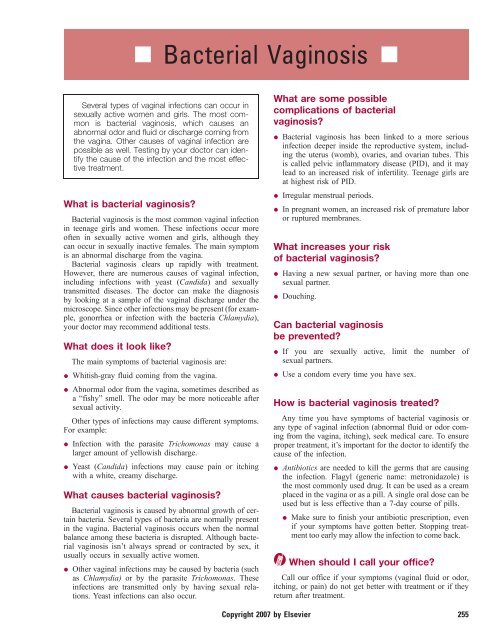Bacterial Vaginosis - Impcna.com
Bacterial Vaginosis - Impcna.com
Bacterial Vaginosis - Impcna.com
Create successful ePaper yourself
Turn your PDF publications into a flip-book with our unique Google optimized e-Paper software.
n <strong>Bacterial</strong> <strong>Vaginosis</strong> n<br />
Several types of vaginal infections can occur in<br />
sexually active women and girls. The most <strong>com</strong>mon<br />
is bacterial vaginosis, which causes an<br />
abnormal odor and fluid or discharge <strong>com</strong>ing from<br />
the vagina. Other causes of vaginal infection are<br />
possible as well. Testing by your doctor can identify<br />
the cause of the infection and the most effective<br />
treatment.<br />
What is bacterial vaginosis?<br />
<strong>Bacterial</strong> vaginosis is the most <strong>com</strong>mon vaginal infection<br />
in teenage girls and women. These infections occur more<br />
often in sexually active women and girls, although they<br />
can occur in sexually inactive females. The main symptom<br />
is an abnormal discharge from the vagina.<br />
<strong>Bacterial</strong> vaginosis clears up rapidly with treatment.<br />
However, there are numerous causes of vaginal infection,<br />
including infections with yeast (Candida) and sexually<br />
transmitted diseases. The doctor can make the diagnosis<br />
by looking at a sample of the vaginal discharge under the<br />
microscope. Since other infections may be present (for example,<br />
gonorrhea or infection with the bacteria Chlamydia),<br />
your doctor may re<strong>com</strong>mend additional tests.<br />
What does it look like?<br />
The main symptoms of bacterial vaginosis are:<br />
Whitish-gray fluid <strong>com</strong>ing from the vagina.<br />
Abnormal odor from the vagina, sometimes described as<br />
a “fishy” smell. The odor may be more noticeable after<br />
sexual activity.<br />
Other types of infections may cause different symptoms.<br />
For example:<br />
Infection with the parasite Trichomonas may cause a<br />
larger amount of yellowish discharge.<br />
Yeast (Candida) infections may cause pain or itching<br />
with a white, creamy discharge.<br />
What causes bacterial vaginosis?<br />
<strong>Bacterial</strong> vaginosis is caused by abnormal growth of certain<br />
bacteria. Several types of bacteria are normally present<br />
in the vagina. <strong>Bacterial</strong> vaginosis occurs when the normal<br />
balance among these bacteria is disrupted. Although bacterial<br />
vaginosis isn’t always spread or contracted by sex, it<br />
usually occurs in sexually active women.<br />
Other vaginal infections may be caused by bacteria (such<br />
as Chlamydia) or by the parasite Trichomonas. These<br />
infections are transmitted only by having sexual relations.<br />
Yeast infections can also occur.<br />
What are some possible<br />
<strong>com</strong>plications of bacterial<br />
vaginosis?<br />
<strong>Bacterial</strong> vaginosis has been linked to a more serious<br />
infection deeper inside the reproductive system, including<br />
the uterus (womb), ovaries, and ovarian tubes. This<br />
is called pelvic inflammatory disease (PID), and it may<br />
lead to an increased risk of infertility. Teenage girls are<br />
at highest risk of PID.<br />
Irregular menstrual periods.<br />
In pregnant women, an increased risk of premature labor<br />
or ruptured membranes.<br />
What increases your risk<br />
of bacterial vaginosis?<br />
Having a new sexual partner, or having more than one<br />
sexual partner.<br />
Douching.<br />
Can bacterial vaginosis<br />
be prevented?<br />
If you are sexually active, limit the number of<br />
sexual partners.<br />
Use a condom every time you have sex.<br />
How is bacterial vaginosis treated?<br />
Any time you have symptoms of bacterial vaginosis or<br />
any type of vaginal infection (abnormal fluid or odor <strong>com</strong>ing<br />
from the vagina, itching), seek medical care. To ensure<br />
proper treatment, it’s important for the doctor to identify the<br />
cause of the infection.<br />
Antibiotics are needed to kill the germs that are causing<br />
the infection. Flagyl (generic name: metronidazole) is<br />
the most <strong>com</strong>monly used drug. It can be used as a cream<br />
placed in the vagina or as a pill. A single oral dose can be<br />
used but is less effective than a 7-day course of pills.<br />
Make sure to finish your antibiotic prescription, even<br />
if your symptoms have gotten better. Stopping treatment<br />
too early may allow the infection to <strong>com</strong>e back.<br />
When should I call your office?<br />
Call our office if your symptoms (vaginal fluid or odor,<br />
itching, or pain) do not get better with treatment or if they<br />
return after treatment.<br />
Copyright 2007 by Elsevier 255
Co pyright 2007 by Elsevie r

















